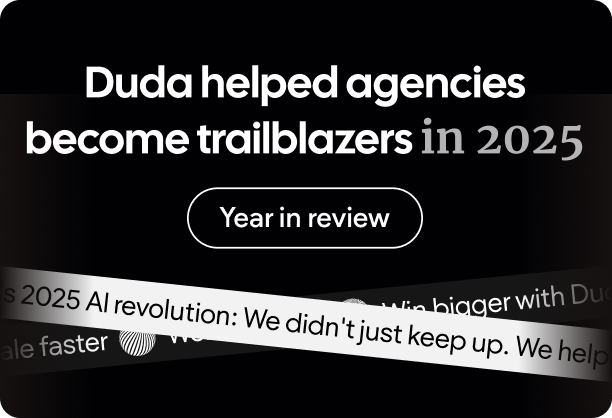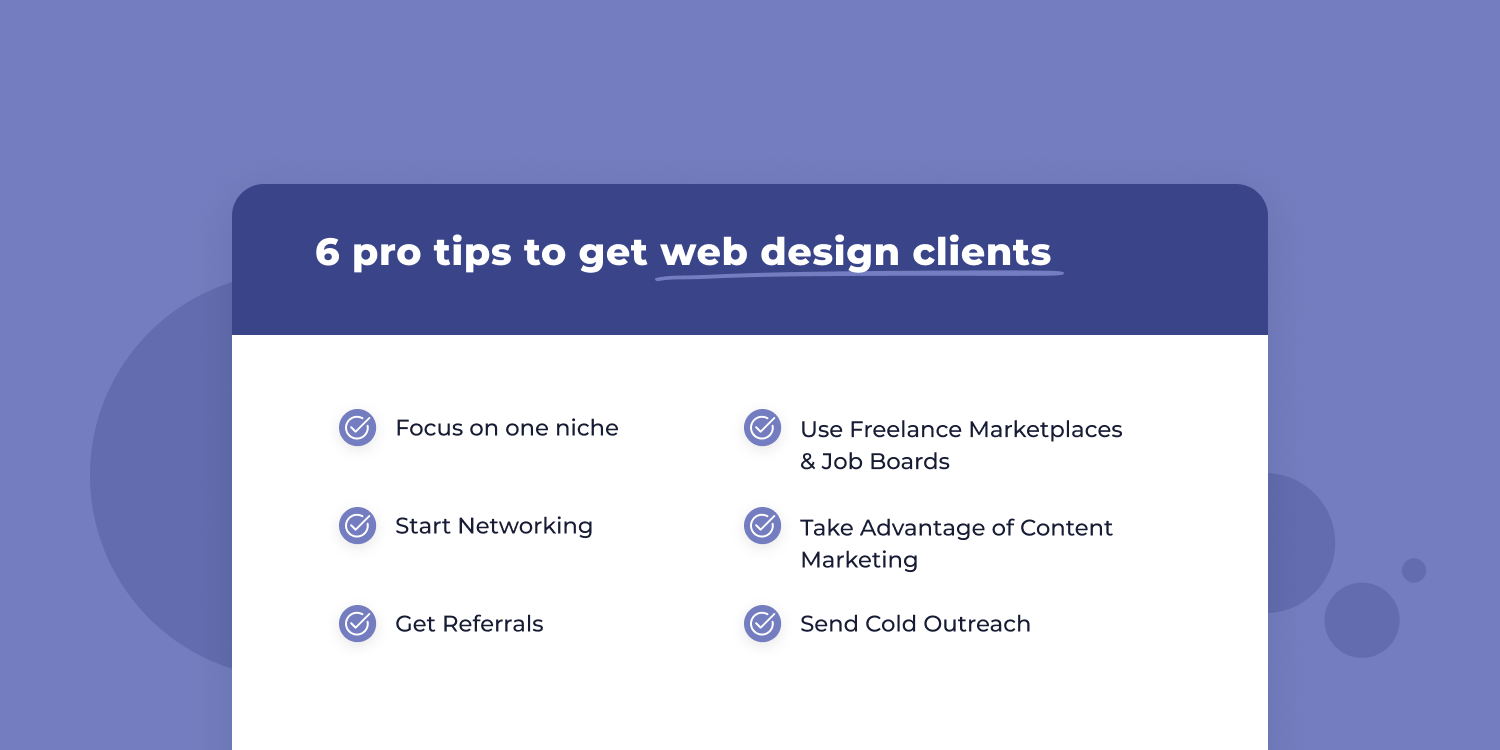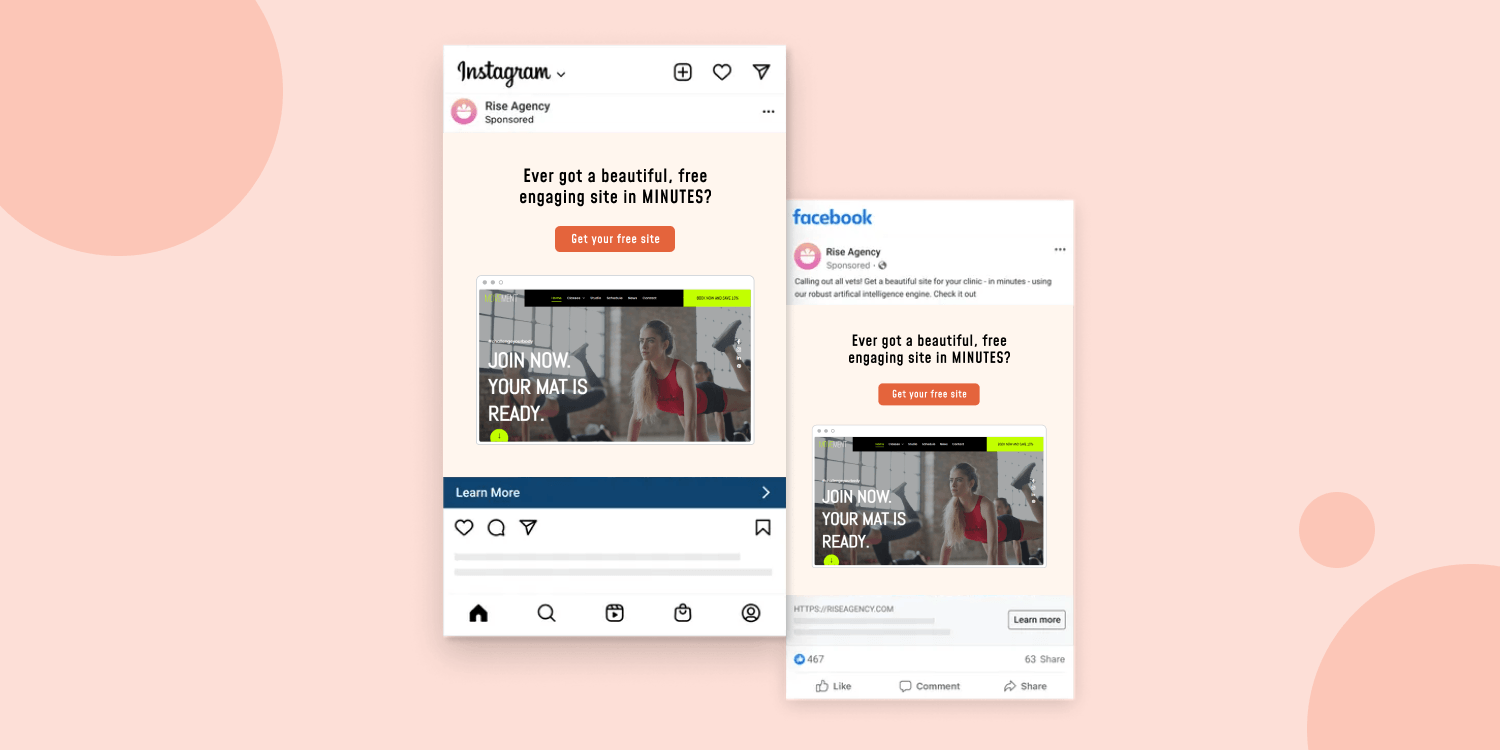1. Focus on one niche
It might seem counterintuitive at first, but as a web design business, focusing your efforts on one niche at a time is a great way to get new clients faster.
By choosing a niche you can really
build an expertise in a specific industry.
Your niche could be determined according to different factors:
- Geographical (Local or regional businesses)
- Industry specific (Construction, restaurants, law firms, fitness centers)
- Psychographics or values related (Vegan, eco friendly, conscious brands)
For example, if you focus on fitness websites, you’ll know what these clients like, how they talk, and what their audience is looking for. This information will help you to sell your website creation services a lot more easily with custom solutions that really resonate with them.
On top of that, you’ll have plenty of relevant
website examples to display as a selling argument and use as templates for your next websites. That’s less web development, and more high quality web design services. Prospective clients will see at a glance how great their website will look if they work with you.
Another advantage of focusing on one niche is that you’ll get to have a
reputation in the industry.
Word of mouth is a powerful tool, and getting references from business owners, entrepreneurs and small businesses within an industry can really help you build a good client base. As an expert in a specific niche, you can increase your pricing, and attract more clients than if you’d be just another generic profile out of millions.
In a nutshell; by focusing on one niche, you’ll be able to attract more clients with less effort and even increase your prices.
2. Start networking
There’s a reason why networking events are still around to this day; it’s a fantastic way to find new business. Nothing can replace real interactions and the trust you build when discussing with someone.
A good way to start networking is to
find local events and associations to join. If you’re targeting the fitness niche, join a few health & fitness-related events, local businesses events, email newsletters, conferences, and facebook groups. Distribute some business cards to potential customers and showcase your web design projects on your own website.
You’ll be surprised at how many new clients you can gain from just a few events per year.
However, remember not to be too salesy and upfront; join the conversation,
ask relevant questions, make connections, but don’t try to sell your services right away.
Build relationships first, then business will follow.
3. Get referrals
You already know that offering a good service to your existing clients is of utmost importance, but it doesn’t only result in happier customers, it can also result in future referrals and testimonials for your website design services.
Think about it, if you need a new hairstylist, which one will you trust more; your friend with amazing hair telling you that their hairstylist is incredible, or an ad telling you that Paolo Pauletto is great?
All you need to do is nurture your client relationships and
ask your most loyal customers to refer to you if they encounter someone needing a new website. Most of the time it will come naturally but it’s always worth asking, you never know how you’ll get your next client.
If you want to get more referrals quicker, you can also
provide an incentive, like a discount, free products, or a commission per referral.
4. Use freelance marketplaces & job boards
A lot of clients will start their search for a service by looking it up on different freelance marketplaces and job boards. Upwork, Fiverr, and Guru being among the most popular.
On Upwork alone, more than 145 000 active clients fill their freelance positions, spending a combined total of over
$2.5 billion every year.
That’s a lot of business you might be missing out on.
On top of that, those websites can be a good first step for you to build your agency portfolio with smaller projects or drive quick revenue to increase cash flow. Finding web design clients can be a lot of work, and you don’t have to be a freelance web designer to be on those apps and find your ideal clients, or first clients. You can use them to help build your startup, diversify your target market, your type of clients, help with lead generation and get more interesting case studies.
So go create your account, showcase your work, pricing, and specifications, bid on projects, and wait for the phone to ring (or notification to pop). You can also use tools like LinkedIn’s recruitment platform, Behance or AwesomeWeb.
All that’ll be left for you to do after that is
create amazing proposals for your clients to get the ball rolling.
5. Take advantage of content marketing
To get started with content marketing, you first need a good website to host all your content, services and portfolio. A great way to get it in minutes is to use
Duda; its builder is made specifically to help you
save time and create powerful and beautiful websites.
Build the perfect agency website right away that’ll bring customers straight to your door, then get started with these content marketing tips.
Blog and website content
Content marketing is frequently forgotten when it comes to getting new clients quickly. Sure, writing blog articles or landing pages in the hope of being found and ultimately closing a sale can seem like a long-term investment. However, using content is an effective way to gain new customers on a regular basis without having to pay for it every time (unlike ads).
A good website content strategy is a great way to promote your services and capture your clients’ attention with specific articles answering their questions and positioning you as the expert and leader in the industry. As an agency, you can talk about the best practices when building your brand, what type of website to have, new trends, and more.
For example, you could write a blog about the best color palettes to use in the health & fitness industry and why. If this article ranks on search engines, every time someone is looking for that specific information, they’ll encounter your website, your brand, your services. That’s evergreen content; steady leads every month, no more work.
The one important thing to keep in mind is to optimize these articles for search engines. It’s a powerful way to be found by your target audience, so make sure you follow
a good SEO checklist before hitting publish.
Social media
Social media platforms are a great way for you to showcase your work and gain more followers, and therefore, more clients.
PPC Ad campaigns
One of the many ways you can leverage social media platforms is to create ad campaigns as part of your digital marketing strategy. You can target your niche or the people who already went on your website, so you only pay for relevant clicks.
You can even use
instant sites in pay-per-click campaigns to boost your revenue at scale with targeted social media ads that
automatically creates a site for your leads. They simply fill a quick form and get a website instantly.
What better way to impress at scale and get a discussion started?
If you want to leverage social media organically, here are a few tips for each platform:
Facebook
On Facebook, the best strategy is to build an online community with a proper business page to showcase your services and keep your clients, friends and family updated. The type of content you should create to garner engagement would be video and animated content, as well as images.
Instagram
Instagram is the perfect platform for designers as it’s an image-focused social media. Take advantage of their tool to wow your audience with an online portfolio that showcases your best work and personality. Don’t forget to use hashtags to reach more than just your closest friends and current clients.
LinkedIn
LinkedIn is great for all your business related content, but also to find new customers. After all, you’re a business, looking for businesses who need your services. Include a few hashtags that could attract the right audience to your posts, create content that discusses best practices, and position yourself as an expert to get the most out of your LinkedIn account. You can also be active in LinkedIn communities, and take advantage of LinkedIn’s Recruiter tool to showcase your services.
Email marketing
Email marketing might sound like just a nice to have, but it is an incredibly effective tool to generate sales.
“Email generates $42 for every $1 spent, which is an astounding 4,200% ROI, making it one of the most effective options available.”
-
Hubspot
You can implement a newsletter on your website, and send weekly or monthly updates with your latest work, blogs, tips, promotions, and more. This will not only help you nurture your relationships with current customers, but also keep you top of mind when it comes to web design for everyone in your email list.
Dedicated emails can also be sent when you start offering new services, to announce great news about the company, or even to ask for feedback and improve your business.
Here are some tips to get the most out of your email marketing outreach:
- Have a short and interesting subject line: Something that’ll make your audience want to know more.
- Don’t spam: Don’t send too many emails every week, and make sure they are always relevant, not just salesy.
- Create automated workflows: When you get a new sign up, make sure they receive automatically some nice emails about your company, services, how you can help them, or other content they might like. Automating makes the work a lot easier for you.
- Segment your audience: If you’re starting to get a lot of different types of traffic (or different industries) segment them so you can send the most relevant content to each person.
Multimedia and downloadable content
From e-books to webinars, courses and videos, there’s a plethora of different downloadable content you can use to help you get more web design clients.
Good educational content can be used as a way of getting new leads and emails. You could, for example, offer an online course (video, webinar, PDF) on your website for free, but simply request that the user enter their email address and name to have access. This way, you build yourself a list of potential clients, who are interested in what you offer, and they get free quality content. Win-win.
Of course, you need to make sure that the content you create will bring the right type of traffic to your site. If for example you create a video on how to design birthday cards for kids, but that you only offer services to tech businesses, your new leads probably won’t convert into clients.
6. Send cold outreach
I know, cold outreach seems so salesy, time consuming, and out of touch, but it really doesn’t have to be! When used properly, cold outreach can be very valuable. Don’t just send cold emails through an automation tool, there are better ways.
Here are a few pointers to keep in mind for a successful outreach:
- Target the right audience: LinkedIn connections, followers, past clients, prospects, leads.
- Come prepared: Before reaching out, take a look at their website, branding, and how you could improve their web design.
- Don’t be too salesy: Ask about them, what they are up to, if they need anything.
- Do follow-ups: Whether it’s by email, social networks or a scheduled meetup, make sure to follow-up from time to time as their needs can change and they need to keep you top of mind.
- Show your value: Don’t just say that you could do XYZ services, tell them why it would be beneficial for them. Will it increase their engagement, sales, traffic?
- Impress them with a custom example: Why not create a website for them in seconds and show it as a selling point? With tools like
Duda’s API this could be done at scale, for all your email reach outs.








